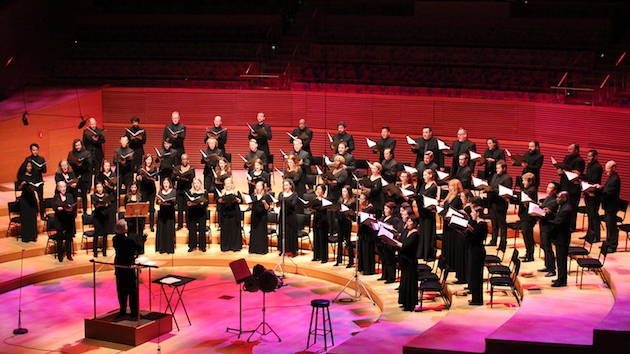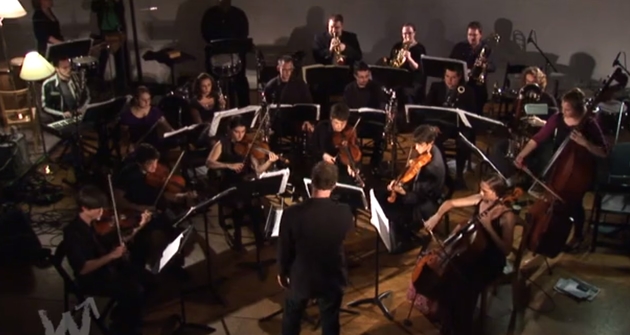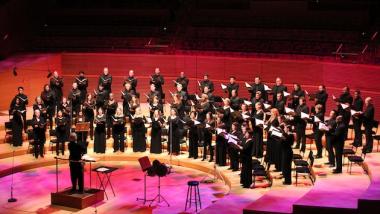
When composer Ellen Reid and Grant Gershon, the director of the Los Angeles Master Chorale, first talked about a collaboration, they played with the idea of creating a work that could be performed in the reverberant concrete tomb that is the Walt Disney Concert Hall parking structure.
On Sunday, that collaboration took place. But the premiere of Reid’s choral/historical panorama dreams of the new world, featuring five vocal soloists, the members of the Master Chorale, and the instrumentalists of wild Up, ended up being played on the concert hall stage, not in the parking lot.
According to Reid, librettist Sarah LaBrie, and lead researcher Sayd Randle, dreams of the new world is the result of two years of in-depth historical research and interviews. It takes the form of a three-part, three-city observation of American history (from 1890 to the present and beyond), with an emphasis on the booms and busts of American westward movement.

Musically, the piece is a brilliant showcase of Reid’s compositional talents. Her orchestral/choral writing is diverse in its fusion of original ideas and influences — from folk and jazz to contemporary post-minimalism. She has an excellent feel for instrumental and choral coloration and a dynamic sense of how her music can provide dramatic contrasts and musical propulsion.
Unfortunately, dreams of the new world is burdened with a libretto that reduces the intricate complexities of American history to the level of simplistic platitudes, hackneyed clichés, and a utopian Star Trek future.
“It’s the American psyche,” the chorus sings in anthem-like tones. “It’s the drive of our forefathers. It’s the great movement westward. It’s freedom.”
Now, it’s possible that this jingoistic motif, which repeats boldly at the beginning of each section, is meant to be taken as tongue-in-cheek sarcasm. But it doesn’t come out that way. It comes out like the type of flag-waving myopia that used to dominate American History textbooks.
Then, as the first two historical sections unfold, discordant threads do find their way into Reid’s American tapestry, threads of racist attitudes and the first murmurings of a Silent Spring environmental consciousness.
“Part 1: Memphis 1890, ‘Freedom’” focuses primarily on the little-known story of Robert R. Church, a former slave who rose to be the city’s first African American entrepreneur, real estate developer, banker, civic leader, and millionaire (though there is some debate about the actual sum of his fortune). There is no question that he was immensely successful and was a key figure in the black community. His three-story Victorian home (at 384 S. Lauderdale St.) regularly received guests that included Frederick Douglass and Langston Hughes.
Reid’s music captures the energy of Memphis as a post-Civil War melting pot of cultures and musical vocabularies. There’s even a “Camptown Races” evocation that could have been composed by Aaron Copland.
As the text explores the life of Church, it credits his role as the creator of a city park and auditorium for African Americans. But then it makes the case (true or not) that the demolition of his home (in 1953 to test new fire equipment) and the subsequent erection of housing units, was at its core a racially-motivated attempt to erase Church’s legacy.

“Part 2: Houston 1970, ‘Prosperity’” offers a wildcatter’s portrait of the city during the boomtown period when Gulf oil gushed, regulation was minimal, and fortunes were made on the oil rigs, then lost on the turn of a card.
In this section, Reid cleverly uses the location to expand her musical toolbox to include recorded effects representing the clang, clatter, and bang of those offshore behemoths.
“Part 3: Los Angeles, ‘Expansion’” envisions Los Angeles as the end of the westward movement and of the launch pad for a future where we will “boldly go where no one has gone before,” colonizing Mars, the moons of Jupiter, and beyond. “Open pod bay doors, HAL.” The interviews for this section, Randle told me, included NASA scientists from the Jet Propulsion Laboratory. However, SpaceX’s Elon Musk was not available for comment.
Before Saturday, I would have thought a truly bad performance of Terry Riley’s In C was impossible. And while Grant Gershon deserves credit for making the choice to program it as the follow-up to Reid’s premiere, the result was a sonic disaster.
The imbalance of 25 singers against the limited instrumental forces of wild Up might have worked if they’d all been placed together on the stage. But Gershon made the decision to place individual musicians and various-sized divisions of the chorale all around the hall. Possibly because of limited rehearsal time, little attention was paid to the overall sound mix. The unfortunate result was a performance that fractured the all-important matrix of sound strata that makes In C work. Most of the instruments scattered around the hall could barely be heard or not at all.
When the performance was greeted with boos, I couldn’t entirely disagree.




